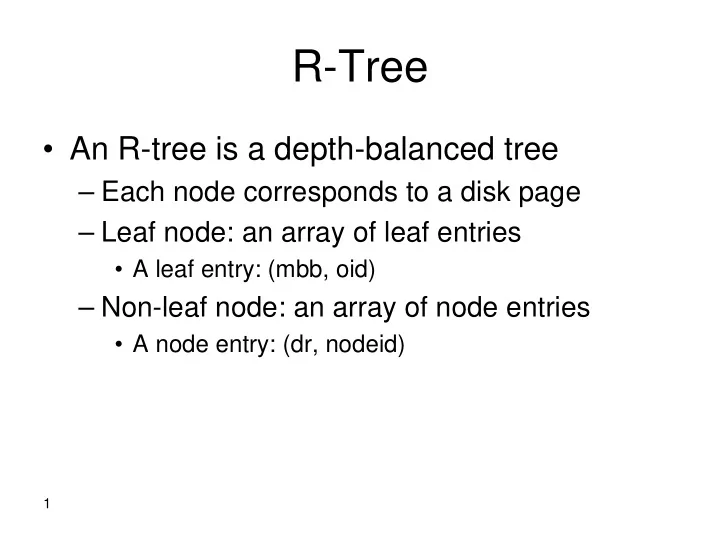

R-Tree • An R-tree is a depth-balanced tree – Each node corresponds to a disk page – Leaf node: an array of leaf entries • A leaf entry: (mbb, oid) – Non-leaf node: an array of node entries • A node entry: (dr, nodeid) 1
1 5 11 14 2 d 6 a c 8 12 13 3 9 b 10 m =2, M =4 7 R 4 a b c d [1,2,5,6] [3,4,7,10] [8.9.14] [11,12,13] 2
Properties • The number of entries of a node (except for the root) in the tree is between m and M where m ∈ [0, M /2] – M : the maximum number of entries in a node, may differ for leaf and non-leaf nodes M = ⎣ ⎦ P : disk page E : entry size ( P ) / size ( E ) – The root has at least 2 entries unless it is a leaf • All leaf nodes are at the same level • An R-tree of depth d indexes at least m d +1 objects and at most M d +1 objects, in other ⎣ − ⎦ ≤ ≤ ⎣ − ⎦ words, log N 1 d log N 1 M m 3
Search with R-tree • Given a point q , find all mbbs containing q • A recursive process starting from the root result = ∅ For a node N if N is a leaf node, then result = result ∪ { N } else // N is a non-leaf node for each child N’ of N if the rectangle of N’ contains q then recursively search N’ 4
Time complexity of search • If mbbs do not overlap on q , the complexity is O(log m N ). • If mbbs overlap on q , it may not be logarithmic, in the worst case when all mbbs overlap on q , it is O( N ). 5
Insertion – choose a leaf node • Traverse the R-tree top-down, starting from the root, at each level – If there is a node whose directory rectangle contains the mbb to be inserted, then search the subtree – Else choose a node such that the enlargement of its directory rectangle is minimal, then search the subtree – If more than one node satisfy this, choose the one with smallest area, • Repeat until a leaf node is reached 6
Insertion – insert into the leaf node • If the leaf node is not full, an entry [mbb, oid] is inserted • Else // the leaf node is full – Split the leaf node – Update the directory rectangles of the ancestor nodes if necessary 7
1 15 5 11 14 2 d 6 a c 8 12 13 3 Insert object 15 9 b 10 m =2, M =4 7 R 4 a b c d [1,2,5,6] [3,4,7,10] [8.9.14] [11,12,13,15] 8
1 15 5 11 14 2 d Insert object 16 6 a c 8 12 13 3 m =2, M =4 R’ 9 b 10 7 16 e R f 4 f R’ a b e c d [1,2,5,6] [3,4,7] [10,16] [8.9.14][11,12,13,15] 9
Split - goal • The leaf node has M entries, and one new entry to be inserted, how to partition the M +1 mbbs into two nodes, such that – 1. The total area of the two nodes is minimized – 2. The overlapping of the two nodes is minimized • Sometimes the two goals are conflicting – Using 1 as the primary goal 10
11
Split - solution • Optimal solution: check every possible partition, complexity O(2 M +1 ) • A quadratic algorithm: – Pick two “seed” entries e 1 and e 2 far from each other, that is to maximize area(mbb(e 1 ,e 2 )) – area(e 1 ) – area(e 2 ) here mbb(e 1 ,e 2 ) is the mbb containing both e 1 and e 2 , complexity O(( M +1) 2 ) – Insert the remaining ( M -1) entries into the two groups 12
Quadratic split cont. • A greedy method • At each time, find an entry e such that e expands a group with the minimum area, if tie – Choose the group of small area – Choose the group of fewer elements • Repeat until no entry left or one group has ( M - m +1) entries, all remaining entries go to another group • If the parent is also full, split the parent too. The recursive adjustment happens bottom-up until the tree satisfies the properties required. This can be up to the root. 13
Recommend
More recommend